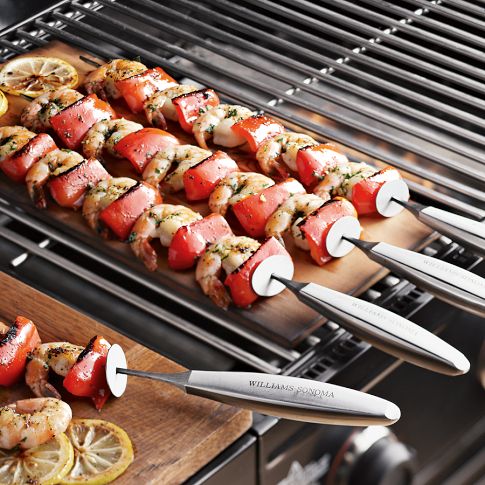When you grill, you hardly need a recipe. Knowing the right technique is what’s important. The key to success, whether with a gas or a charcoal grill, often involves creating two zones: one for high, direct heat and another for low, indirect heat.
The direct-heat area is where you begin, searing the meat with the lid open. Thicker cuts are then moved to the indirect-heat zone to finish cooking, with the lid closed; the meat won’t burn, and it will stay moist.
Here, you’ll learn how to set up those two zones and get tips and cooking times for fish, chicken, different cuts of steak, and pork chops. You’ll also find recipes for barbecue sauces and advice on maintaining your grill so it’s always ready to fire up for another fine meal.
Grilling Tips to Live By:
- Bring steaks and pork chops to room temperature before grilling them. Keep fish and chicken refrigerated.
- Season foods generously on both sides with salt and pepper.
- Preheat the grill to medium-high.
- When searing foods, always keep the lid open.
- Don’t flip food often or move it around (unless you’re doing so to avoid flare-ups).
- Let steaks, chops, and chicken rest for 10 minutes before serving.
Grilling Whole Fish How-To:
A whole fish, such as red snapper, branzino, or black bass makes an elegant meal. (See how to grill it for cooking times.)
- Plan on one 1 1/2- to 2-pound fish for two ample servings.
- Add seasonings to the cavity of a cleaned, scaled fish: salt, pepper, a drizzle of good olive oil, lemon slices, and sprigs of fresh thyme. Rub the outside of the fish generously with olive oil; this will help keep the skin from sticking to the grill. (It may happen anyway; the fish won’t look as pretty but will still taste delicious.)
- The fish will cook quickly over direct heat.
- To test for doneness, insert a metal skewer into the thickest part. It should not meet resistance and should come out warm.
- Drizzle with more olive oil and lemon juice before serving.
Grilling Chicken How-To:
Chicken is by far the hardest thing to get right on the grill: The skin often burns before the meat is cooked through. Brining chicken parts — soaking them in a seasoned, salted liquid — is worth the extra effort for the flavor and moistness it adds. But this step is optional. (See how to grill it for cooking times.)
- If possible, brine the meat before grilling.
- Start all parts on direct heat, skin side down, to crisp the skin. Drumsticks, breasts, and thighs will be moved to indirect heat to cook through.
- For the breast pieces: When you move them to indirect heat, position the thicker end closer to the direct-heat zone. (This will allow the breast to cook evenly.)
- If the fire flares up, move the chicken pieces around. If it continues, remove chicken until flames subside.
- If using barbecue sauce, brush it on at the end of the cooking time — not on the raw chicken — so it doesn’t burn.
- When done, each piece should have crisp golden skin, and the juices should run clear when the meat is pierced.
Grilling Steaks How-To:
The secret to a great steak, whatever the cut, is a good, hot grill, as the heat causes the meat to form a flavorful dark-brown crust. Here are four of our favorite steaks. Rib eyes can be a bit of a splurge, but skirt, flank, and hanger are economical as well as delicious. (See how to grill it for cooking times.)
- Some cuts benefit from a marinade, which will tenderize meat and add flavor. Use barbecue sauce as a condiment.
- Start steaks on direct heat. Some thicker ones finish on indirect heat.
- Don’t move steak while it cooks; this will keep it from searing.
- With practice, you can tell by touch when your meat is ready. Press your finger into the middle of the steak. If it feels soft and mushy, it is very rare. If it feels slightly firm with some spring, it’s medium-rare to medium. If it feels very firm to the touch, it’s well-done or overcooked.
- Always slice steaks against the grain.
Tips For Grilling Bone-In Rib Eye:
Plan on a 1-pound, 1- to 1 1/2-inch-thick steak per person. Richly marbled rib eye is a luscious cut of meat. The fat melts while it’s grilling, making it especially succulent. Rib eye needs no marinade. Just season it well before grilling, and drizzle it with some good olive oil just before serving.
Tips For Grilling Skirt:
Plan on 1/4 to 1/2 pound per person. Skirt’s fattiness gives it deep flavor. This thin cut can start to break down if marinated too long; four hours is ideal. Skirt usually comes in a long strip that’s thin on one end and about an inch thick at the other end. Cut it in half, and cook the two pieces quickly — the thicker longer than the thinner, and not beyond medium-rare. Slice it thinly on an angle
Tips For Grilling Flank:
Plan on 1/4 to 1/2 pound per person. This large cut is great for crowds. A marinade will tenderize it and impart flavor. Flank has one thin end and one thick end. After searing it, move it to indirect heat and position the thick end closer to the direct-heat zone to cook it evenly.
Grilling Bone-In Pork Chops How-To:
Pork today is bred to be very lean, which means it’s hard to cook without drying it out. Bone-in rib chops have a bit more fat, adding flavor and moistness. Brining is an unexpected step but worth the effort.
- Plan on one or two 1/2-pound, 1-inch thick pork chops per person.
- If possible, brine the pork chops.
- Grill pork chops over direct heat.
- Brush barbecue sauce on during the last few minutes of cooking. Or squeeze lemon juice over the top before serving.
- When the pork chops are done, the exteriors should be lightly golden with hatch marks. The interiors should be juicy and just barely pink. – Martha Stewart Living









1 comment so far ↓
Just discovered your blog! Absolutely love it!!!
xox Mrs. Châtelaine in Paris
Leave a Comment